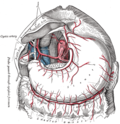| Splenic artery | |
|---|---|
 The visceral surface of the spleen. | |
 Branches of the celiac artery. (Lienal artery is an old term for splenic artery, and is visible at center. The spleen is at center right. The stomach has been flipped out to reveal the splenic artery, so the greater curvature is at the top in this diagram.) | |
| Details | |
| Source | Celiac artery |
| Branches | Pancreatic branches pancreatica magna left gastro-omental short gastric trabecular arteries posterior gastric |
| Vein | Splenic vein |
| Supplies | Spleen |
| Identifiers | |
| Latin | arteria splenica, arteria lienalis |
| MeSH | D013157 |
| TA98 | A12.2.12.040 |
| TA2 | 4239 |
| FMA | 14773 |
| Anatomical terminology | |
In human anatomy, the splenic artery or lienal artery, an older term, is the blood vessel that supplies oxygenated blood to the spleen. It branches from the celiac artery, and follows a course superior to the pancreas. It is known for its tortuous path to the spleen.





